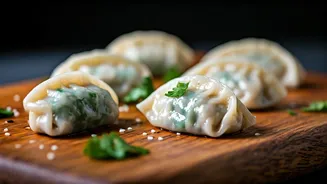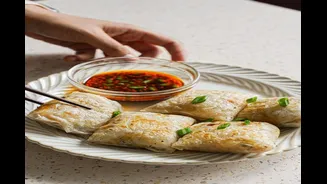Dumplings: The Basics
Rice paper dumplings offer a refreshing take on the classic dumpling. Their appeal lies in the delicate texture of the rice paper, which encases a flavorful
filling. Unlike traditional dumplings made with wheat-based wrappers, these are naturally gluten-free, making them suitable for those with dietary restrictions or anyone seeking a lighter alternative. Their versatility allows for diverse fillings, from savory vegetables and meats to sweet options, catering to a wide range of tastes. Preparation is relatively simple: rice paper sheets are softened in water, filled, and then either steamed, pan-fried, or served fresh. This adaptability has made rice paper dumplings a popular choice for both home cooks and professional chefs globally. These dumplings can easily be customized according to one's preference or taste buds.
Gather Your Ingredients
To embark on this culinary journey, you'll need a few essential ingredients. First, procure rice paper sheets—the key to these gluten-free dumplings. Next, choose your filling. Options abound, but consider a mixture of finely chopped vegetables such as carrots, cabbage, and mushrooms for a classic savory filling. Protein options range from lean ground meat to tofu. Seasonings play a crucial role, with soy sauce or tamari (ensure it's gluten-free), sesame oil, ginger, and garlic adding depth of flavor. For a touch of freshness, include herbs like cilantro or scallions. A dipping sauce, such as a mixture of soy sauce, rice vinegar, and a hint of chili, will complete the experience. The ingredients are designed to be quite flexible. One can substitute with many options, based on preference and availability.
Preparing the Filling
The preparation of the filling is critical to the final taste and texture of the rice paper dumplings. Begin by sautéing any meat or protein of your choice. Next, finely chop your selected vegetables into small, uniform pieces to ensure even cooking and distribution. Stir-fry the vegetables until they soften slightly, allowing their natural sweetness to develop. Incorporate the cooked protein and vegetables, and add seasonings to taste. Use a light hand with soy sauce or tamari, balancing it with sesame oil and ginger. Season well but avoid over-salting, as the dipping sauce will contribute additional flavor. Allow the filling to cool slightly before assembling the dumplings. This ensures that the rice paper doesn't tear when you handle it.
Wrapping the Dumplings
Assembling the rice paper dumplings can be a fun and satisfying process. First, prepare a shallow dish of warm water. Dip a rice paper sheet in the water for a few seconds until it becomes pliable but not overly soft. Place the softened rice paper on a clean, flat surface. Add a spoonful of the filling to the center of the rice paper. Fold the edges of the rice paper over the filling, creating a neat package. Be careful not to tear the rice paper; if it does, it's okay, just use another sheet and practice makes perfect. Repeat this process with the remaining rice paper sheets and filling. The folding technique is similar to that of a spring roll, so if you have any experience with those, it will prove a helpful skill.
Cooking the Dumplings
Once you have assembled your dumplings, it's time to cook them. You have several options here. Steaming is a classic method, preserving the delicate texture of the rice paper and the freshness of the filling. Place the dumplings in a steamer basket and steam for a few minutes until they are heated through. Alternatively, pan-frying offers a slightly crispier texture. Heat a small amount of oil in a pan and cook the dumplings until they are lightly golden brown on the outside. Serve the rice paper dumplings fresh and warm, with your preferred dipping sauce. These dumplings can also be served cold, making them suitable for meal prep or a light summer meal.
Perfect Dipping Sauce
The dipping sauce elevates the flavor of rice paper dumplings. The base of the dipping sauce should be soy sauce or tamari for a savory foundation. Add a splash of rice vinegar for acidity, balancing the richness of the filling. A touch of sesame oil enhances the nutty flavor, and finely chopped chili or a dash of chili oil will contribute a desirable kick. Finely chopped scallions or cilantro also contribute fresh flavors and visual appeal. Taste and adjust the ingredients according to your preference. Remember, the dipping sauce is meant to complement the dumplings and can be tailored to suit individual tastes. Experiment with different combinations to discover your favorite pairings.
Serving and Enjoying
Present your rice paper dumplings beautifully. Arrange the cooked dumplings on a plate, garnishing with fresh herbs or a drizzle of dipping sauce for visual appeal. Offer the dipping sauce separately, allowing each diner to control the level of flavor. These dumplings can be served as an appetizer, a side dish, or a light main course, depending on portion size. They are perfect for family meals, dinner parties, or any occasion. Rice paper dumplings are relatively easy to prepare, making them an excellent choice for a quick and impressive meal. Enjoy the satisfying combination of textures and flavors. These dumplings can easily become a favorite gluten-free meal option.














